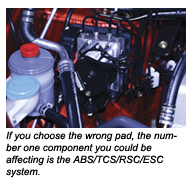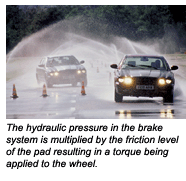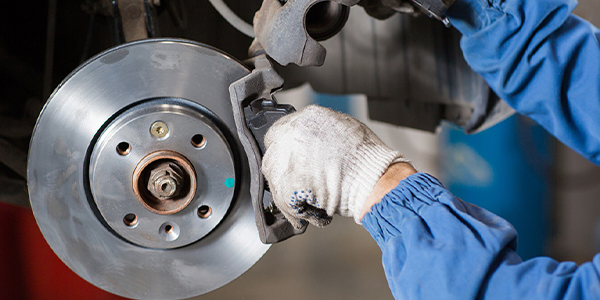At most shops, the person ordering brake pads is given the choice of a several levels of brake pads. The good, better and best marketing is sorted out by price and brand rather than solid engineering data. Sometimes the tech has no choice when the choice is dictated by a supply relationship for friction materials.
In today’s brake friction market, many sources put warranty before engineering on the parts ordering screen. This can leave the person ordering the pads in a difficult position when his goal is to select the right brake pad for safety and emergency stopping performance. Also, what effects can a replacement brake pad have on the ABS, traction and stability systems.
 ABS, TCS and ESC
ABS, TCS and ESC
Everybody who installs or orders brake pads should be asking themselves the following questions: Will installing replacement brake pads from any source impact the performance of the safety systems that use brake control? Also, are all these new safety systems capable of adapting to different brake pads?
To understand these questions and evaluate the potential answers, it is first important to have a basic understanding of the various chassis control systems the “wheel brakes” support and what are the operating principles and control strategies they employ. There are essentially five general chassis control systems available on today’s vehicles. On some vehicles they are standard and on others they are options available to the car buyer. They are offered by a variety of manufacturers and sold under a broad range of trade names.
The first building block is ABS (Anti-Lock Brake System). This is the basis for all the remaining technologies. The primary function of ABS is to manage the slip (lockup tendency in engineering speak) of each tire and control the amount of slip each tire is allowed. This is done to optimize the ability of the tire to generate longitudinal tire forces and lateral tire forces. This is engineering jargon which means how much stopping power and cornering power the tire, and ultimately the vehicle, can generate. In other words, the system allows the driver to brake and turn at the same time.
EBD (Electronic Brake Force Distribution) is the next extension of ABS. This system replaces the function of the traditional proportioning valve and manages the front to rear brake balance of the vehicle across all vehicle loading conditions and road surface conditions.
TCS (Traction Control System) is essentially ABS in reverse. TCS works to allow the tire to provide the maximum longitudinal tractive force during acceleration and also match the engine output to the level the road surface can absorb.
The next extension of these technologies is ESC (Electronic Stability Control). This technology takes the path the vehicle is really travelling and compares this to where the driver really wants to go. If the two do not match, the vehicle is either understeering or oversteering.
Once one of these conditions is identified, the brake system is activated to provide a rotation force on the vehicle to get it back on track. It is kind of like sticking a paddle in the water of a canoe to force a turn.
The most recent technology emerging on some vehicles is Roll Stability Control(RSC). This system evaluates the tendency of a vehicle to roll over and once the onset of a roll is identified, the wheels on one side of the vehicle are heavily braked in order to reduce the amount of lateral adhesion. The goal is essentially to put the vehicle into a side slide to prevent the role tendency.
The control algorithms for all these systems are extremely sophisticated and contain literally thousands of individual parameters that are tuned specifically to the particular vehicle line and brake system used on the vehicle. These parameters are developed, refined and tuned on a large variety of maneuvers, speeds and road conditions.
It is certainly reasonable to wonder, after all the work to develop a fully integrated set of systems, what happens when a different set of friction material is put on the car, or more commonly, on one axle of the car during service?
To understand the potential effects, we must go a bit deeper into how these systems generally operate. In all of these systems, the computer controller (the brains of the system) is monitoring the vehicle watching for an indication that an undesirable operating condition starts to appear.
 These systems closely monitor individual wheel speeds, vehicle deceleration, engine output, steering wheel angle, yaw rate, lateral acceleration and roll rate among many other secondary indicators. The controller uses all of this information to determine very precisely what the vehicle is doing compared to the desired behavior of the driver. Then a corrective action plan is determined. The brain then commands a “torque change” (or “torque” in engineering shorthand) to the desired wheel brake. The system can not directly control torque. It can only control hydrualic pressure.
These systems closely monitor individual wheel speeds, vehicle deceleration, engine output, steering wheel angle, yaw rate, lateral acceleration and roll rate among many other secondary indicators. The controller uses all of this information to determine very precisely what the vehicle is doing compared to the desired behavior of the driver. Then a corrective action plan is determined. The brain then commands a “torque change” (or “torque” in engineering shorthand) to the desired wheel brake. The system can not directly control torque. It can only control hydrualic pressure.
The desired correction may be a torque increase, decrease or hold. An individual torque command is developed for each wheel independently.
The hydraulic pressure in the brake system is multiplied by the friction level of the pad resulting in a torque being applied to the wheel.
Torque Confusion
The system, based on all the tuning and teaching that was used to develop the system, assumes that for a given pressure command, a given torque correction will result.
Remember it is torque that ultimately creates the desired vehicle reaction. By changing the pads to a material that has a different friction value, you have changed half the equation the system is counting on.
As a result, the system will not get the torque reaction it expects for an optimum result. All of these systems operate on what is called a feedback control principle. In simple terms, this means the system calculates its best estimate of the required amount of correction and applies it. It then watches to see if that estimate was effective.
If it sees that it did not get the job done, it calculates another correction and applies again. This cycle continues throughout the event. By the way, the system is checking its progress at the rate of approximately 100 times each second and employing corrective actions perhaps around 10-15 times a second in multiple directions.
When the friction value changes, which it will most certainly do with different friction material, the system will not get to the best correction as quickly as it was capable of when it had all of the parts it was expecting. In most cases, the system will learn and correct for the “error” the new pads have introduced. It just will take more tries to get there and take longer. This results in reduced efficiency by some measurable factor.
The systems will still operate and still provide substantial improvements in vehicle handling control and safety vs. not having them. They are highly adaptable, but they just won’t be as perfect as they once were. In most cases, this will be very difficult, if not impossible, to detect at the driver seat.
If you were to measure the true performance of the vehicle by things like stopping distance, amount of steering correction, amount of pedal feedback and more complicated things like yaw gains and maneuver entry speeds, you could expect to find measurable degradation under many maneuvers.
Since the system is generally very good at minimizing these effects, it would be easy to convince the driver/ consumer that this is of no consequence and that they should not consider this as part of their buying decision when it comes to selection of brake replacement.
The ability to “copy” a friction material’s characteristics is a very difficult task under the best of circumstances. All service technicians should consider that the OEMs and developers of these systems have invested thousand of hours by some really smart and dedicated people and spent millions of dollars to tune these systems to their maximum capability and insure they work in absolute harmony with the rest of the vehicle.
While this is done in some pretty obscure and unfriendly environments at times, it is all done to ensure maximum performance and control in the blizzard, torrential downpour or when the dog jumps in front of YOUR car. Any decision to compromise this balance should be given careful consideration. As a general guideline, I would offer the following few thoughts:
If you chose to not use high-quality replacement pads that mirrors the original friction characteristics, always chose a material with the same friction rating on the edge code. (EE, FF) etc.
If you chose to change the friction level to a different value (i.e. from EE to FF), change it on all four wheels together. Do this regardless of the level of wear on the other axle, and regardless of whether you are choosing to raise or lower the friction level. This will at least ensure that the braking ratio from front-to-rear is maintained as much as possible.
Never replace only the Rear Brakes with a pad that has a higher friction level than what is specified for the vehicle. This will increase the amount of rear braking and increase the potential for a rear over brake condition under some road surface and loading conditions. In the modern vehicle, the wheel brake is challenged to contribute to a great many vehicle driving conditions extending way beyond just stopping the car. The friction material is a very key element in this. To maintain the optimum performance, it is important to understand the implications of the choices that are being offered to consumers and help them make an educated decision.













